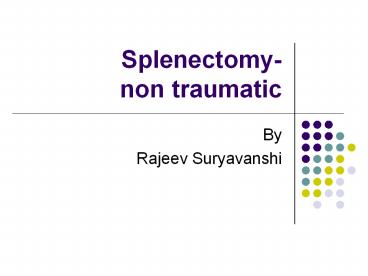Splenectomy- non traumatic - PowerPoint PPT Presentation
1 / 20
Title:
Splenectomy- non traumatic
Description:
Splenectomy- non traumatic By Rajeev Suryavanshi Indications Trauma commonest Spontaneous rupture - Infect mono - Malaria Hypersplenism - H ... – PowerPoint PPT presentation
Number of Views:1062
Avg rating:3.0/5.0
Title: Splenectomy- non traumatic
1
Splenectomy- non traumatic
- By
- Rajeev Suryavanshi
2
Indications
- Trauma commonest
- Spontaneous rupture
- - Infect mono
- - Malaria
- Hypersplenism
- - H. spherocytosis
- - Elliptocytosis
- - ITP
- Neoplasia
- - Leukemia
- With other viscera
- - Total Gastrectomy
- - D. Pancreatectomy
- Others
- - Hydatid
- - abscess
3
Infectious Mononucleosis
- Glandular fever
- 1920 article , John Hopkins Med bulletin
- Triad- fever, lymphadenopath, pharyngitis
- 80 Epstein Barr Virus
- Remaining majority CMV
4
Syndrome consist of
- Fatigue, Fever, Splenomegaly, Adenopathy and
Pharyngitis. - Transmission - kissing
- Incubation 30 - 50 days
- Incidence 50/100,000 general population
- - 5000/100,000 Susceptible
college students. - Age 15 24 years.
5
Virus and pathogenesis
- EBV- double stranded DNA virus.
- 2 stage pathogenesis-
- Stage1- virus infects oropharygeal
epithelial cells. - Stage 2- infectious virus invading
- B-lymphocytes, multiply.
- Circulating B cells cause involvement of
Reticulo-endothelial system.
6
Immune response
- Primary immune respons -
- NK cells
- CD4 Suppressor T Lymphocytes
- Target on infectious cells.
- Secondary immune response -
- CD8 T Lymphocytes for EBV
7
Clinical Features
- Prodrome (3-5 days)
- - malaise, fatigue,
- headache, anorexia.
- Fever (mod high) grade, Chills /_
- Tender, symmetrical, lymphadenopathy usually
cervical
- 60 -75 show Splenomegaly-2 weeks after illness.
- lt 30 Hepatomegaly
- 10 Jaundice
- Posterior palate petechiae.
- 10 Maculopapular rash
8
Laboratory features
- CBC leukocytosis (10-20,000)
- Absolute lymphocytosis gt 50 in diff.
- Atypical Lymphocytosis gt 10
- (B cells with virus)
- Transient neutropenia
- Liver functions- increase in
Aminotransferases, ALP, - LDH and Bilirubin
9
serology
- Test for Infectious mononucleosis related
immunoglobulin M (IgM) heterophil antibodies.
10
Differential diagnosis
- GABHS
- (Group A beta-Hemolytic pharyngitis).
- HIV
- Typhoid .
11
Complications
- Upper air way obstruction.
- Spontaneous splenic rupture.
- Others-
- Cardio respiratory-
- Pneumonitis
- Myocarditis
- Pericarditis
- Hematological-
- Autoimmune anemia
- Thrombocytopenia.
- Hepatic
- Cholestatic jaundice
- Hepatic necrosis
- Neurological
- CN palsy
- Encephalitis
12
Upper air way obstruction
- Cause Tonsillopharyngitis.
- Best use of corticosteroid in this situation.
- Timely use of steroids can prevent surgical
intervention. - Emergency tonsillectomy may be needed on
occasion, if steroid fail to respond or
uncontrolled bleeding from tonsil.
13
Spontaneous splenic rupture
- Rate 1 in 1000 cases of infectious mono.
- Also seen in CMV, and Hep.A infection.
- Rupture seen lifting, walking, coughing,
vomiting , defecating. - Time of rupture 2-4 weeks, from start of
illness. - Capsule of spleen infiltrated by lymphocytes.
14
Spontaneous splenic rupture
- Usual presentation
- - pain, left upper abdominal.
- - tenderness in LUQ
- - Kehrs sign.
- Diagnosis- CT scan / ultrasonography
- if patient is stable
- If unstable DPL / Surgical intervention.
15
Management
- Supportive
- No specific therapy
- Rest and Fluids.
- Acetaminophen / Aspirin fever.
- Lozenges / Salt water gargles
- Antibiotics and Steroids are indicated in
presence of complication.
16
Steroid indication in infectious mononucleosis.
- Impending upper airway obstruction.
- Immune cytopenia
- Neurological complications
- Severe Hepatitis
- Myocarditis.
- Extreme fever
17
Overwhelming post Splenectomy infection(OPSI)
- Infection due to encapsulated bacteria.
- 50 Strep. Pneumoniae.
- Other organisms-
- Haemophilius influenzae
- Neisseria meningitidis
- Incidence is 4 in post splenectomy patients
without prophylaxis. - Mortality is 50 of OPSI
- Highest risk in first 2 years after splenecotmy.
18
Prevention of OPSI
- Antibiotic prophylaxis-
- penicillin or amoxicillin
- duration ? Life long
- for sure in kids up to 16 years of age.
- Immunization-
- Pneumococcal and Haemophilius
- given 2 weeks before elective surgery
- immediately post op for emergency cases.
- repeat every 5 -10 years.
19
Return to play and work
- Individualize each patient.
- Recent recommendations for return to contact
sports (3 weeks 3months) - Practical guide is
- if patient feels well, LFT normal, suggest
resuming light training as jogging , swimming
usually after 4 weeks of illness.
20
Thank you

